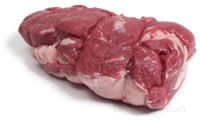|
Roasts for Braising
Tougher cuts of lamb that contain a large quantity of collagen
(connective tissue) are ideal candidates for braising. The long
slow cooking of braising dissolves the collagen, creating a rich,
smooth sauce that is used as an accompaniment for the roast. The
majority of the lamb carcass is tender enough for dry heat cooking
methods, which leaves only a few cuts that require braising or stewing
for the best results.
|
|
Neck
The neck is a small, tough, flavorful cut usually sold whole or
cut into crosswise slices, and is cooked using moist heat. When
braised, the fat and collagen in the neck melts, which helps to
tenderize the meat. Because of the large quantity of bone in the
neck, it is best to purchase at least a pound for each serving.
Neck is excellent when trimmed and cubed for stew meat and it may
also be ground.
|
|
Whole Breast
The whole bone-in breast can be used as a roast when cooked with
moist heat. It is often boned and rolled in which case it is usually
stuffed and braised.
|
|
Foreshank
The foreshank is the leanest cut of lamb and requires long slow
cooking with moist heat to dissolve the connective tissue. It may
be left whole or cut across the bone into rounds. The foreshank
is also known as simply a lamb shank, but this can be confusing
because the lower part of the shank half of the rear leg is also
known as a lamb shank. A lamb shank is also known as a trotter.
|
|
Shank Half of Leg Roast, Bone-in

|
The shank half of the leg is leaner than the sirloin half, but it
is tougher and chewier and has a higher percentage of bone. It becomes
tender and succulent when properly prepared using moist heat cooking
methods. It typically weighs 3 to 4 pounds. The shank half-leg is
often confused with "lamb shank", which most often refers
to the foreshank, but may also refer to the lower end of the shank
half of the rear leg. |
|
Shank Half of Leg Roast, Boneless

|
The shank half of the rear leg can be boned, rolled, and tied to
form a roast suitable for braising. |
|
Rear Leg Shank

|
A lamb shank usually refers to the foreshank, but this can be confusing
because the lower end of the rear leg is also known as a lamb shank.
To make it even more confusing, the entire lower half of the rear
leg is referred to as the "shank half", but this cut is
much larger than a lamb shank and includes part of the center leg.
Foreshanks and the rear leg shanks may also be referred to as trotters.
They may be braised whole or cut across the bone into slices for stew.
Shanks must be braised or stewed to tenderize the meat. |

